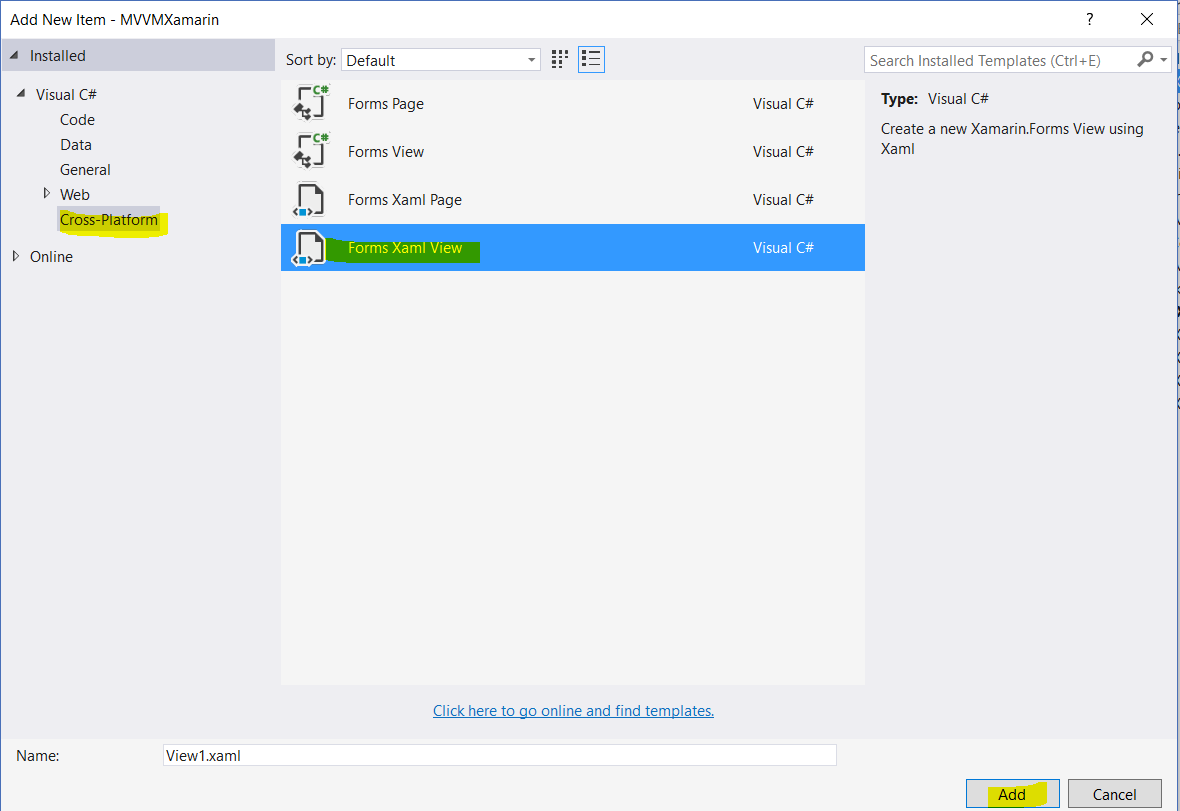Binding Control to Control in Xamarin Forms
 Create New Xamarin. Forms Application:
Create New Xamarin. Forms Application:
Let's start with creating a new Xamarin Forms Project in Visual Studio.
Open Run - Type Devenev. Exe and enter - New Project (Ctrl+Shift+N) - select Blank Xaml App (Xamarin. Forms Portable) template.
You can refer my previous article forcreate new xamarin forms application from here - http://www.c-sharpcorner.com/article/how-to-create-first-xamarin-form-application/

Binding Control to Control using
Data bindings can be defined to link properties of two Controls on the same page. In this case, you set the BindingContext of the target object using the x: Reference markup extension.
In the following sample added one Entry control and Label control forprint text
<StackLayout >
<Entry x: Name ="txtname "></Entry>
<Label Text="Welcome Mr.." VerticalOptions="Center" HorizontalOptions="Center" />
<Label BindingContext="{x: Reference Name=txtname }" Text="{Binding Path=Text}"
VerticalOptions ="Center" HorizontalOptions="Center" />
</StackLayout >
Entry Control Name : txtname
Label control adding Binding Context and Binding the value.
Whileassign binding Context, we can use following two way
BindingContext ="{x: Reference Name=txtname } OR BindingContext="{x: Reference txtname } // Name attribute is not required
Same like while assign valueto property, we can use following two way
Text="{Binding Path=Text}" OR Text="{Binding Text}" // Path attribute is not required

<Label BindingContext="{x:Reference Name=txtname}" Text="{Binding Path=Text, StringFormat='Welcome Mr {0}'}"/>
<StackLayout >
<Entry x: Name ="txtname "></Entry>
<Label BindingContext="{x:Reference Name=txtname}" Text="{Binding Path=Text, StringFormat='Welcome Mr {0}'}"
VerticalOptions ="Center"
HorizontalOptions ="Center" />
</StackLayout >
label.SetBinding(Label.TextProperty, new Binding("<Property Name>", stringFormat: "Welcome Mr {0}", source: <BindingContext Control name>));
or
var label = new Label{ BindingContext = <Control Name> };
label.SetBinding(Label.TextProperty, new Binding("<Property Name>", stringFormat: "Welcome Mr {0}"));
StackLayout layout = new StackLayout( );
var editor = new Editor( );
layout . Children. Add( editor);
var label = new Label( );
label.SetBinding(Label.TextProperty, new Binding("Text", stringFormat: "Welcome Mr {0}", source: editor));
layout . Children. Add( label);
this . Content = layout;

In xaml and C# file, change content View to any layout control like Grid, Stack layout
<Grid xmlns="http://xamarin.com/schemas/2014/forms" xmlns:x="http://schemas.microsoft.com/winfx/2009/xaml" x:Class="MVVMXamarin.MyControl">
<Label Text="{Binding Text, Source={x:Reference this}}" />
</Grid>
In Code behind file, you might want to make your control, have a bindable property to pass data through to it, on each page it is used. First, create a Bindable Property in your UserControl. It doesn’t have to be bindable if you just want to pass a static value through, however if you want to bind to it, you must make it bindable.
using System ;
using System.Collections.Generic;
using System.Linq;
using System.Text;
using System.Threading.Tasks;
using Xamarin. Forms;
namespace MVVMXamarin
{
public partial class MyControl : Grid
{
public MyControl()
{
InitializeComponent();
}
public static readonly BindableProperty TextProperty = BindableProperty.Create(nameof(Text), typeof(string), typeof(MyControl));
You can refer my previous article for
Binding Control to Control using xaml :
Data bindings can be defined to link properties of two Controls on the same page. In this case, you set the BindingContext of the target object using the x: Reference markup extension.In the following sample added one Entry control and Label control for
<
<Entry x
<Label Text="Welcome Mr.." VerticalOptions="Center" HorizontalOptions="Center" />
<Label BindingContext="{x
</
Entry Control Name
Label control adding Binding Context and Binding the value.
While
Same like while assign value
Text="{Binding Path=Text}" OR Text="{Binding Text}" // Path attribute is not required
Binding Control with String Builder:
All the database data or other srorage data is not formatted data so you Can bind Property with string or any type like below<Label BindingContext="{x:Reference Name=txtname}" Text="{Binding Path=Text, StringFormat='Welcome Mr {0}'}"/>
<
<Entry x
<Label BindingContext="{x:Reference Name=txtname}" Text="{Binding Path=Text, StringFormat='Welcome Mr {0}'}"
</
Binding Control in C#:
You can do it effectively the same way as the XAML example simply by setting your view's BindingContext or Source to the other view.label.SetBinding(Label.TextProperty, new Binding("<Property Name>", stringFormat: "Welcome Mr {0}", source: <BindingContext Control name>));
or
var label = new Label{ BindingContext = <Control Name> };
label.SetBinding(Label.TextProperty, new Binding("<Property Name>", stringFormat: "Welcome Mr {0}"));
label.SetBinding(Label.TextProperty, new Binding("Text", stringFormat: "Welcome Mr {0}", source: editor));
Binding User Control:
Xamarin Forms doesn’t have a control called a User Control. However, we can make any VisualElement, or combination of Visual Element’s into a reusable control, to use on different pages, just like a User Control.Create User Control:
Right Click PCL project > Select” Forms XAML View” and click on AddIn xaml and C# file, change content View to any layout control like Grid, Stack layout
In Xaml Page:
<?xml version="1.0" encoding="UTF-8"?><Grid xmlns="http://xamarin.com/schemas/2014/forms" xmlns:x="http://schemas.microsoft.com/winfx/2009/xaml" x:Class="MVVMXamarin.MyControl">
<Label Text="{Binding Text, Source={x:Reference this}}" />
</Grid>
In Code behind file, you might want to make your control, have a bindable property to pass data through to it, on each page it is used. First, create a Bindable Property in your UserControl. It doesn’t have to be bindable if you just want to pass a static value through, however if you want to bind to it, you must make it bindable.
using System.Collections.Generic;
using System.Linq;
using System.Text;
using System.Threading.Tasks;
{
public partial class MyControl : Grid
{
public MyControl()
{
InitializeComponent();
}
public static readonly BindableProperty TextProperty = BindableProperty.Create(nameof(Text), typeof(string), typeof(MyControl));
public string Text
{
get
{
return (string)GetValue(TextProperty);
}
set
{
SetValue(TextProperty, value);
}
}
}
}
Going to your MainPage, you can now assign a value to the Text property. You can also use {Binding PropertyName} if you want, as this is a bindable property.
<StackLayout >
<Entry x: Name ="txtname "></Entry>
<local:MyControl BindingContext="{x:Reference Name=txtname}" Text="{Binding Path=Text, StringFormat='Welcome Mr {0}'}">
</local:MyControl>
</StackLayout >

{
get
{
return (string)GetValue(TextProperty);
}
set
{
SetValue(TextProperty, value);
}
}
}
}
Going to your MainPage, you can now assign a value to the Text property. You can also use {Binding PropertyName} if you want, as this is a bindable property.
<
<Entry x
<local:MyControl BindingContext="{x:Reference Name=txtname}" Text="{Binding Path=Text, StringFormat='Welcome Mr {0}'}">
</local:MyControl>
</















0 Comments